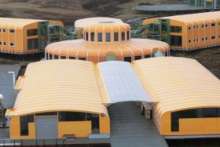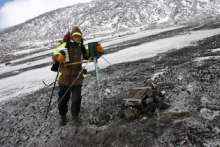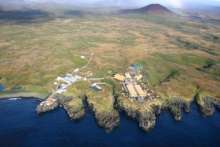SA's new R200m, high-tech Marion Island science hub
|
- By Irma Venter
Cape L'Agulhas is the most southern tip of South Africa.
Right?
Wrong.
There is a place about 2 160 km south of Cape Town that is also South African territory - the Prince Edward Islands.
Marion Island, the larger of the islands group, is situated at 46°54' south, and 37°5' east in the Southern Indian Ocean.
The island is in what is called the ‘roaring forties' - a rather hostile-sounding nickname referring to the often gale-force Westerly winds blowing between the 40°S and 50°S latitudes throughout the year.
Marion Island is about 290 km2 in size, with 72 km of mostly cliff-face coastline. The much smaller Prince Edward Island spans only 45 km2.
From Cape Town, it takes about five days to reach the islands by ship.
In 2002, the Department of Environmental Affairs and Tourism (Deat) approved the budget to build a new base on Marion Island, to replace the 40-year-old base that was reaching the end of its designed lifespan.
Taking the decision to build the new base was the easy part, though. Constructing it has been a completely different story.
A bit of history
The first mention of the Prince Edward Islands dates back to March 4, 1663, when a Dutch East Indiaman, the 1 210-t Maerseveen, under commander Barent Barentzoon Ham, passed them en route to Java.
Some time later, Marion Island was named after the French naval officer, Marion de Fresne, of the frigate Le Mascarin, who, on his way south in search of Antarctica, rediscovered the islands in 1772.
Famous explorer James Cook also sailed past the islands but, like those before him, did not land, mainly owing to adverse weather conditions and a treacherous rocky coastline that prohibited easy access.
However, these explorers' documentation of the rich animal life prompted hunters to establish shelters on the islands, culling seals for their fur and oil.
Today, both these islands belong to South Africa, which annexed them in 1948, owing to their strategic position in terms of defence and navigation, as well as for weather forecasting. (Unlike Marion Island, Prince Edward Island is a pristine conservation area, hosting many different species of seals, penguins and birds, and human occupation is not allowed. It acts as a control laboratory against which the impact of human activities on Marion Island and other sub-Antarctic islands can be measured.)
Establishing a meteorological station was initially the prime reason for South Africa to continue occupation of the island beyond the 1950s.
Today, these meteorological activities remain one of the most important motivations for the base, as they play an important role in weather forecasts for South Africa, as well as in understanding the global climate.
However, the island is also crucial for navigation purposes in the Southern Indian Ocean, as many passing ships rely on information from the Marion Island base.
Also, decades of scientific and mainly biological research has built up a virtual mine of information, and now forms one of the other major reasons for maintaining a base on the island.
Marion Island hosts many South African and foreign scientists, studying bird, seal and insect life. The island is also in a convenient location. It sits rather snugly halfway to Antarctica, where South Africa has another weather and research base.
International law requires that South Africa maintain a presence on the Prince Edward Islands to ensure it remains the owner.
Touching base
The R200-million Marion Island base will be 85% complete in May this year, when the current construction window expires, says Deat South African National Antarctic Programme operational management, logistics and project management assistant director Adriaan Dreyer, writing from Marion Island, where he is leading the new-base project.
There are typically two construction windows a year - March to May, and August to November - working around inclement weather and ship delivery schedules to the island.
"The anticipated completion date is April next year," says Dreyer.
The aim is to construct a base that will last for 30 years, requiring little maintenance, and which is able to house 80 people.
The current Marion Island base hosts a year-team of 12 people, with up to 80 people descending on the island in summer. (For those who are curious, there are currently four female scientists on the island, including one from Australia, as well as a female kitchen assistant. During the summer handover period, there will be 26 women on the island, including architects, scientists, students, conservationists, and South African Weather Service staff.)
While the new base is being constructed, the existing one remains operational, allowing the long-running research and weather observation programmes to continue without interruption.
"We'll keep the old base operational for at least a year after we have completed the new base, to make sure the new facility lives up to expectations," says Dreyer.
He adds that the old base will eventually be dismantled and returned to South Africa.
Construction of the new base has already been delayed by two years, owing to harsh weather conditions and the limited availability of ships from Deat as well as of construction workers.
Deat's fleet also services South Africa's Gough Island weather station, and the country's Antarctic research base, explains Dreyer, and the shipment of construction crews and building material to Marion Island depends on the fleet schedule.
To date, the outer structure of the new base has already been completed, with work now continuing on the interior, installing carpets, inner walls and wiring.
"Water supply has been completed, and the three generators have already been installed and are all operational," notes Dreyer. Water for the base originates from a dam situated 2,4 km north-west of the base, through a newly installed 160-mm diameter water pipeline.
The 6 000-m2 facility will be powered by Perkins diesel generators, with four uninterruptible power units on standby.
The modular base consists of a central hub, which includes the medical and communication facilities; the living area, with a kitchen, dining room and bar; the recreational area, with ablution facilities, a gym, a jacuzzi and a sauna; the research and science building; sleeping quarters; and, lastly, the technical centre, which houses the generators, workshops, stores and the launching pad for weather balloons.
A new hangar supports two Super Puma helicopters, a workshop area, an emergency first-aid area, and an emergency base for 12 people.
In total, the base has 843 light fittings, and 1 350 power points, says Dreyer.
Nine observation and overnight four-sleeper huts have also been replaced with new structures.
Construction of the new base is the responsibility of the Department of Public Works.
The start of construction followed a detailed environmental-impact assessment.
Endecon Ubuntu Consulting Engineers is the structural design company on the project.
Endecon Gauteng office manager Cobus Erasmus says the most challenging aspect of designing the new base has been obstacles presented by the environment.
(Among the more than 60 recorded visits to the islands between discovery and annexation, there is reference to at least eight vessels that have floundered off the Prince Edward Islands, which hints at the area's rough seas and the prevailing weather conditions on the island.)
"Consider the adverse weather conditions in which construction has to take place: wind speeds can reach 150 km/h and more - on a regular basis - then add rain, storms, extreme cold and the marshy terrain," says Erasmus.
"This meant we could only consider materials suited to the terrain, and capable of enduring the adverse weather conditions."
Erasmus says evidence of this is the fact that the foundations of the new base are not the traditional foundations used when constructing buildings on dry land and under sunny skies.
"Also, the buildings are only a few metres away from the ocean. We had to use corrosion-resistant stainless-steel columns (piles) which had to be driven into the ground on rocky outcrops underneath the ground surface. These columns supported the platforms on which the buildings have been constructed."
The large volume of rain on the island ensures that the surface of the volcanic island is covered by a more-than-four-metre-thick muddy mire.
These marshy conditions meant that it was also impossible to use traditional construction heavy-weights, such as bulldozers and front-end loaders. (The volume of rain is actually of concern at the moment, as it has dropped from the 2,5-m annual average, to below 2 m.)
The 50-strong construction team has been able to make use of two cranes, though.
While the nine overnight huts were dropped by helicopter, this exercise could not be repeated with the roof and wall panels, largely owing to cost concerns.
"These large panels would have required specialised helicopters," explains Erasmus.
The panels were, therefore, downsized, and lowered into position by the two cranes.
All of the floor panels were placed by hand, some of them weighing a few hundred kilograms.
Owing to environmental concerns, concrete may not be mixed on Marion Island, which meant the base couldn't feature any bricks or concrete flooring, adds Erasmus.
Special glass-reinforced plastic (GRP) - a type of fibreglass - boasting good insulation properties, was used for all the panels.
These panels were designed and manufactured in South Africa, from where they were shipped to the island.
"This was achieved through extensive research and testing to create the product most suitable to the conditions," says Erasmus.
Other features of the base include covered walkways and hallways between the climate-controlled buildings, because of the adverse weather.
"People can move between the buildings without being exposed to the weather," says Erasmus.
He notes that the design method used for the Marion Island base "is now being replicated by other overseas designers for bases in the Antarctic, and similar harsh environments".
Of mice, and braaing men
Marion Island has something of a mouse problem.
It is hoped the new base will contain these hungry rodents, as they will be unable to eat through the GRP material.
It is believed the mice came from the ships that weighed anchor at the island over the years, with their large reserves of fresh water.
In 1960, cats were introduced onto the island, in a bid to reduce the mouse population. However, in a classical cause-effect scenario, this led to a several-thousand-strong cat population, threatening the island's bird life. In fact, a species of night bird was nearly driven into extinction during the reign of the cats.
By the late 1980s, rampant cat numbers were brought down by shooting the animals.
This meant the mice remained, again scavenging food from the base.
"The base is completely sealed in order to keep the mice out. All doors, openings and windows are mouseproof," says Erasmus.
Another unique feature of the base is its specially designed enclosed braai room. After all, things just wouldn't be complete without this truly South African feature.
Once completed, this room will have a gas braai, as well as a traditional charcoal braai, says Dreyer. It will boast large panoramic windows offering views of the snowcapped mountains, the ocean, and Prince Edward Island.
Source: Engineering News Online





